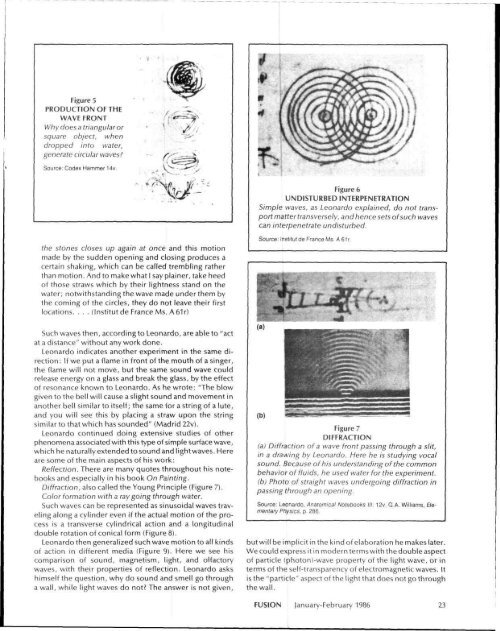Figure 4WAVES AT THE DISCONTINUITYBETWEEN WATER AND AIR(a) "... the impetus of the water is divided into twoparts. . . . The simple is entirely beneath the surfaceof the water; the other is complex, that is, it is betweenthe air and the water as is seen with boats. ..."Here, sketches by Leonardo of the surface phenomena.(b) A drop of water strikes the water's surface andrebounds. The drop that strikes is the same thatbounces back, as may be proven by using a drop ofcolored water against a surface of clear water. Inset isLeonardo's sketch. Source: fa) Codex Hammer 14v; (b) Codice Atlantico 68rb.This is not an isolated quotation from Leonardo; thereare many more in the same direction, which proves thatLeonardo had grasped a very important point clearly. Theimplications are that water surface, being a surface of discontinuity,will behave like a specific entity. It is an equipotentialsurface of discontinuity, if we consider the Earthand the atmosphere as a connected global geometrical entity.It is through such lines or surfaces that action actsaccording to the least action principles. Normally the tendencyis to brush away the specific property that the watersurface presents in terms of free energy, with the name"surface tension," which explains nothing and is simply anapproximation of reality from a Newtonian standpoint. Asone contemporary scientist, Hunter Rouse of Iowa University,put it: "For many years, the surface phenomena wereexplained in terms of apparent tension in an elastic skin. . . .As a matter of fact there are so many inconsistencies in thesurface tension concept that the continued designation ofthe quantity (d) as a coefficient of surface tension is, to saythe least, misleading. . . ."' 8Before elaborating on this in conjunction with shockwaves, let us look at some of the effects of such surfaces. Ifinstead of throwing a stone into water, we throw anotherdrop of water, what will happen? We can see in Figure 4(b)that the water drop bounces back. The photograph is madeby a very recently developed high-speed technique, butthe drawing in the figure is from Leonardo. You can see hewas studying the same phenomenon, and his descriptionis a very good approximation of the reality. Even if Leonardoobviously could not see that the same drop would reboundup to three or four times, he analyzed it in terms of theboundary conditions of the surface of discontinuity. 19Waves. What happens when we drop stones into water?We see "waves." The question Leonardo posed is, why arethese waves circular? From the drawing in Figure 5, it isclear that it is not the form of the object thrown into thewater that causes the waves to be circular. (Actually thewaves are spherical, including air and water, but we observeonly a surface.)As shown in Figure 6, Leonardo saw a specific propertyof such waves: They could interpenetrate without obstructingeach other. The reason is that this type of simple wavedoes not transport matter transversely. As Leonardo wrote:Since in all cases of motion, water has great conformitywith air. . . if you cast two little stones ... in water,you will see two separate quantities of circles . . . whichgrowing, come to encounter, one circle intersectingthe other, always maintaining for centers the placesstruck by the stones. The reason is that although thereis some evidence of movement, the water does notleave its location, because the opening made in it by22 January-February 1986 FUSION
Figure 6UNDISTURBED INTERPENETRATIONSimple waves, as Leonardo explained, do not transportmatter transversely, and hence sets of such wavescan interpenetrate undisturbed.the stones closes up again at once and this motionmade by the sudden opening and closing produces acertain shaking, which can be called trembling ratherthan motion. <strong>And</strong> to make what I say plainer, take heedof those straws which by their lightness stand on thewater; notwithstanding the wave made under them bythe coming of the circles, they do not leave their firstlocations. . . . (Institutde France Ms. A61r)Source: Institut de France Ms. A 61 r.Such waves then, according to Leonardo, are able to "actat a distance" without any work done.Leonardo indicates another experiment in the same direction:If we put a flame in front of the mouth of a singer,the flame will not move, but the same sound wave couldrelease energy on a glass and break the glass, by the effectof resonance known to Leonardo. As he wrote: "The blowgiven to the bell will cause a slight sound and movement inanother bell similar to itself; the same for a string of a lute,and you will see this by placing a straw upon the stringsimilar to that which has sounded" (Madrid 22v).Leonardo continued doing extensive studies of otherphenomena associated with this type of simple surface wave,which he naturally extended to sound and lightwaves. Hereare some of the main aspects of his work:Reflection. There are many quotes throughout his notebooksand especially in his book On Painting.Diffraction, also called the Young Principle (Figure 7).Color formation with a ray going through water.Such waves can be represented as sinusoidal waves travelingalong a cylinder even if the actual motion of the processis a transverse cylindrical action and a longitudinaldouble rotation of conical form (Figure 8).Leonardo then generalized such wave motion to all kindsof action in different media (Figure 9). Here we see hiscomparison of sound, magnetism, light, and olfactorywaves, with their properties of reflection. Leonardo askshimself the question, why do sound and smell go througha wall, while light waves do not? The answer is not given,Figure 7DIFFRACTION(a) Diffraction of a wave front passing through a slit,in a drawing by Leonardo. Here he is studying vocalsound. Because of his understanding of the commonbehavior of fluids, he used water for the experiment.(b) Photo of straight waves undergoing diffraction inpassing through an opening.Source: Leonardo, Anatomical Notebooks III: 12v. G.A. Williams, ElementaryPhysics, p. 286.but will be implicit in the kind of elaboration he makes later.We could express it in modern terms with the double aspectof particle (photon)-wave property of the light wave, or interms of the self-transparency of electromagnetic waves. Itis the "particle" aspect of the light that does not go throughthe wall.FUSION January-February 1986 23
















